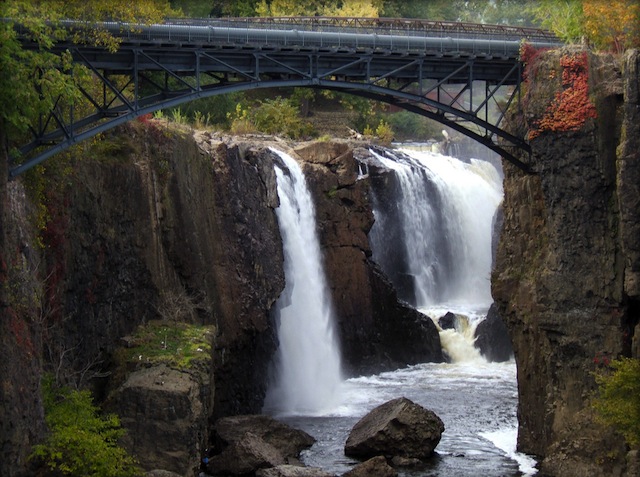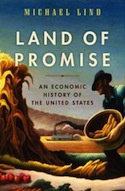
For centuries, technological innovation and political upheaval in America came hand-in-hand: the steam engine and the American Revolution, electricity and the Civil War, information technology and World War II. We can draw on this history of reinvention to emerge from our current recession, argues Michael Lind. Lind visits Zócalo to discuss whether our old government can catch up to our new economy. Below is an excerpt from his book, Land of Promise: An Economic History of the United States.

At the Great Falls of the Passaic River in New Jersey, two dozen miles from New York City, a torrent rushes over the rocks and plunges with a thunderous roar to the river 77 feet below. Thirteen thousand years ago during the last Ice Age, the Passaic River followed a different course. When the glacier that had covered much of North America melted, it deposited a moraine of boulders that formed a dam, blocking the river’s course. Diverted along the Watchung Mountains of New Jersey, the river gouged a new course, bursting through layers of two-hundred-million-year-old basalt to create the largest waterfall in North America south of Niagara Falls.
It was here, on July 10, 1778, during the American War of Independence, that General George Washington of the Continental Army chose to rest and dine. Relaxing with him that day were the marquis de Lafayette, the aristocratic young French volunteer who would return home to fight for liberal constitutionalism in the French Revolution, Colonel William McHenry, later to be secretary of war of the United States, and Washington’s young aide-de-camp, Alexander Hamilton. The contents of the picnic are recorded by history-ham, tongue, and biscuits-but no record remains of the conversation.
It is certain, however, that Hamilton was impressed by the natural power of the falls. As the first Treasury secretary of the United States during the administration of President George Washington, Hamilton chose the Great Falls of the Passaic as the site for the Society for Establishing Useful Manufactures (SUM), an industrial corporation chartered in 1791 by the New Jersey legislature and Governor William Paterson, after whom the new factory town on the company’s land would be named. The creation of the SUM followed the Report on Manufactures delivered to Congress in 1791, in which Hamilton called for a variety of federal policies to promote industry in the young United States.
Hamilton’s grandiose plans for the “National Manufactory” were not realized. But the SUM survived until 1945, when it sold its assets to the city of Paterson, by leasing its land to a number of increasingly sophisticated manufacturing concerns. To create a system of raceways diverting water from the river through mills, the society hired the French engineer and urban planner Pierre L’Enfant, who later planned the city of Washington, D.C., only to replace him with Peter Colt, who used a simpler plan.
With the water-power infrastructure in place, Paterson became a flourishing center of industrial production. The township was soon the site of a cotton mill (1794), a candlewick mill (1800), and a paper mill (1804). As the new railroads spread across the continent, Paterson became a center of steam-powered locomotive production, leading the industry by the 1850s.
Hamilton, like Washington, was a champion of American manufacturing in part because of the difficulty experienced by the Continental Army during the American Revolution in obtaining adequate supplies. The tradition of U.S. military support for the development of new technologies, including radio, atomic power, and computers, shaped the growth of Paterson from its earliest days. A deputy director of SUM, John Colt, perfected a nonmildewing cotton cloth that the navy used for the sails of all its ships in order to free itself from foreign suppliers. When Samuel Colt, a relative of Peter and John Colt, invented the revolver, he opened his company in Paterson and found indispensable customers in the Texas Rangers and the U.S. Army, whose procurement orders helped bankroll the development of the new technology. In the 1870s, an Irish American inventor in Paterson, John Philip Holland, experimented with submarine technology. In 1890, the U.S. Navy named its first commissioned submarine the U.S.S. Holland in his honor.
By the end of the 19th century, when the town was the source of almost half of the silk in the United States, Paterson was known as “Silk City.” A strike by Paterson silk workers in 1913 attracted worldwide attention and the support of bohemian intellectuals like the journalist John Reed and Mabel Dodge Luhan, who sponsored an avant-garde pageant at Madison Square Garden to publicize the strike. The pageant was a success but the workers were crushed and Paterson and other northern textile centers lost out to competitors in the American South.
But once again, Paterson reinvented itself by taking advantage of technological innovation. Two of the transformative technologies of what historians call the second industrial revolution were electricity and aviation. In the 1900s, the SUM enlisted Thomas Edison and his company to design one of the world’s first hydroelectric power plants. The mills switched from old-fashioned waterpower to electricity from the plant, which opened in 1914 and still generates energy for Paterson today.
Soon the former Silk City became Aviation City, hosting the Wright Aeronautical Corporation, which was established by the inventors of the airplane, Orville and Wilbur Wright. Wright Aeronautical manufactured the custom-made engine that Charles Lindbergh used in his epochal solo flight across the Atlantic in 1927. The successor to Wright Aeronautical, the Curtiss-Wright Corporation, went on to play a major role in aircraft production during World War II, contributing to the Allied victory against the Axis powers in Europe and Asia.
In the second half of the 20th century, Paterson declined because of competition first from the low-wage American South and then from the state-sponsored industries of Asia and Europe. Symbolizing the rising importance of real estate and financial interests in the U.S. economy, realtors sought to destroy much of the old industrial neighborhoods, which were plagued by dereliction and crime. The federal government, however, turned the Great Falls and their environs into a national park, reflecting another trend in deindustrializing America: nostalgic historic preservation. It remained to be seen whether the alternatives proposed for the once-great manufacturing city of Paterson, New Jersey-speculator-built condos and apartments or relic-filled museums of a lost industrial past?-represented local decline or a prophetic vision of a future American economy that had completely ceded high-value-added manufacturing to its military and economic rivals.
Buy the Book: Skylight Books, Powell’s, Amazon.
From Land of Promise by Michael Lind. Copyright © 2012 by Michael Lind. Reprinted courtesy of Harper, an imprint of HarperCollins Publishers.
*Photo courtesy of Tony Fischer Photography.




Send A Letter To the Editors